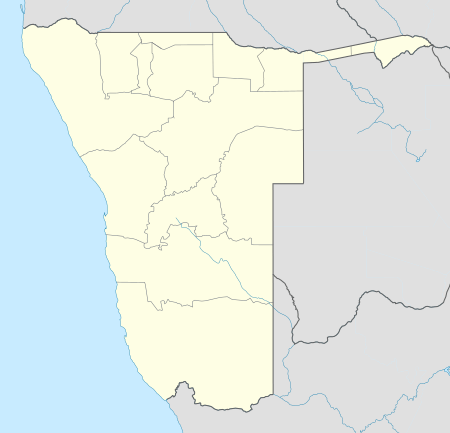Outapi
Outapi wa Nakafingo na Temba, also Outapi or Uutapi and Ombalantu, is a town in northern Namibia near the border with Angola situated 90 km (56 mi) northwest of Oshakati. It is the capital of Omusati region and the district capital of the Outapi electoral constituency. The language spoken there is Oshiwambo.
Outapi Ombalantu | |
|---|---|
Main street in Outapi | |
 Seal | |
 Outapi Location in Namibia | |
| Coordinates: 17°31′S 15°0′E | |
| Country | |
| Region | Omusati Region |
| Population (2011)[1] | |
| • Total | 6,437 |
| Time zone | UTC+2 (SAST) |
| Climate | BSh |
The town normally receives an annual average rainfall of 440 millimetres (17 in), although in the 2010/2011 rainy season 723 millimetres (28.5 in) were measured.[2]
Economy and infrastructure
In 2001, Outapi was the smallest town in Namibia, with a population of just over 2,600.[3] It is, however, developing rapidly. There is a large number of newly constructed government buildings and shops in the south of the town. The town features several schools, a community hall, a hospital and a police station.[4] There are two open markets, one at the baobab tree and one at Onhimbu. There is also a tourist lodge.
Culture and tourism
Within the former South African Army base is the famous Omukwa Ombalantu baobab tree, a baobab whose huge hollow trunk has been used in the past as a post office, a chapel, and a coffee shop, and now houses a craft shop.[5]
The town hosts the annual Olufuko Festival, which was initiated in 2012. The festival is a combination of a business expo and cultural celebrations, of which the initiation ceremony that prepares teenage girls for womanhood is the heart of the festival. Namibia's first president and founding father, Sam Nujoma, is the patron of the Olufuko Festival.
Politics
Outapi is governed by a town council that has seven seats.[6]
Omusati Region, to which Outapi belongs, is a stronghold of Namibia's ruling SWAPO party. For the 2015 local authority election no opposition party nominated a candidate, and SWAPO won all seven seats uncontested.[7]
References
| Wikimedia Commons has media related to Outapi. |
- "Table 4.2.2 Urban population by Census years (2001 and 2011)" (PDF). Namibia 2011 - Population and Housing Census Main Report. Namibia Statistics Agency. p. 39. Retrieved 24 August 2016.
- Menges, Werner (26 May 2011). "Rainy season was one for the record books". The Namibian. Archived from the original on 15 December 2011.
- Republic of Namibia 2001 Population and Housing Census (Basic Analysis with Highlights ed.). Windhoek: Central Bureau of Statistics, National Planning Commission. July 2003. p. 21. ISBN 0-86976-614-7.
- "Presidential and National Assembly Elections 2009". Supplement to several Namibian newspapers. Electoral Commission of Namibia. November 2009.
- "North (Omusati): Ombalantu Baobab Tree Heritage Centre and Campsite". Namibia Travel Online. Archived from the original on 11 May 2011. Retrieved 16 March 2011.
- "Know Your Local Authority". Election Watch (3). Institute for Public Policy Research. 2015. p. 4.
- "Local elections results". Electoral Commission of Namibia. 28 November 2015. p. 6. Archived from the original on 10 December 2015.